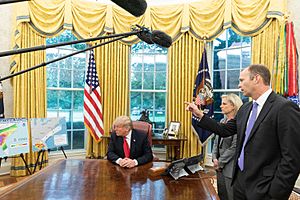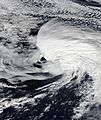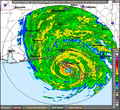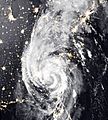Hurricane Michael facts for kids
| Category 5 major hurricane (SSHWS/NWS) | |
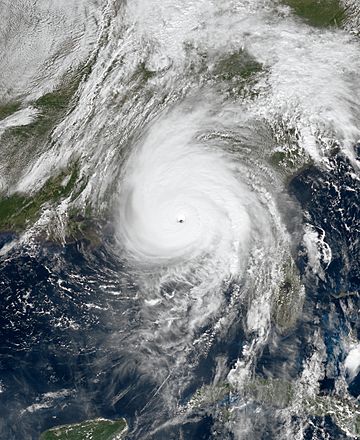
Hurricane Michael at peak intensity shortly before landfall on the Florida Panhandle on October 10
|
|
| Formed | October 7, 2018 |
|---|---|
| Dissipated | October 16, 2018 |
| (Extratropical after October 11) | |
| Highest winds | 1-minute sustained: 160 mph (260 km/h) |
| Lowest pressure | 919 mbar (hPa); 27.14 inHg |
| Fatalities | 31 direct, 43 indirect |
| Damage | $25.5 billion (2018 USD) |
| Areas affected | Central America, Yucatán Peninsula, Cayman Islands, Cuba, Southeastern United States (especially the Florida Panhandle and Georgia), Eastern United States, Eastern Canada, Iberian Peninsula |
| Part of the 2018 Atlantic hurricane season | |
Hurricane Michael was a very powerful storm that hit the United States in October 2018. It was one of the strongest hurricanes ever to hit the Florida Panhandle. Michael was the strongest storm to strike the U.S. since Hurricane Andrew in 1992. It was also the fourth strongest hurricane to hit the mainland U.S. based on its wind speed.
This storm was the 13th named storm and the second major hurricane of the 2018 Atlantic hurricane season. Michael started as a large area of low pressure in the Caribbean Sea. It grew stronger as it moved north. Michael became a hurricane near Cuba and then a major hurricane in the Gulf of Mexico. It reached its strongest point as a Category 4 hurricane when it hit Mexico Beach, Florida. The storm caused a lot of damage and sadly, many people lost their lives.
Contents
How Hurricane Michael Formed and Grew
Hurricane Michael began as a wide area of low pressure over the southwestern Caribbean Sea on October 2. At first, strong winds high up in the atmosphere stopped it from growing. But slowly, the storm started to get more organized. It moved towards the Yucatán Peninsula.
By October 6, the storm had strong thunderstorms, but it didn't have a clear center yet. Because it was getting close to land, weather experts started watching it closely. On October 7, radar showed that the storm had a closed center. It was then named Tropical Storm Michael.
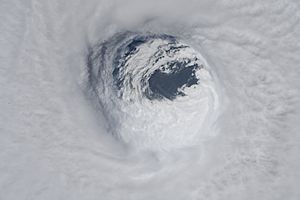
Michael quickly became stronger. It turned into a hurricane on October 8 as it passed near the western tip of Cuba. The storm then moved into the Gulf of Mexico. It started to get much stronger very quickly. This is called rapid intensification. A clear "eye" of the hurricane began to form.
On October 9, Michael became a major hurricane. Its central pressure dropped very quickly, showing how powerful it was becoming. Michael reached its strongest point on October 10, just before hitting land. It was a high-end Category 4 hurricane with winds of 155 miles per hour (250 km/h). It hit the coast near Mexico Beach, Florida. This made it one of the most intense hurricanes ever to hit the United States.
After hitting land, Michael quickly lost strength. It moved over the southeastern United States. The eye of the storm disappeared. About 12 hours after landfall, it weakened to a tropical storm. As it moved towards the Mid-Atlantic States, it changed into a different type of storm called an extratropical cyclone on October 12.
Preparing for the Storm
People and governments took many steps to get ready for Hurricane Michael.
Cuba's Preparations
About 300 people living in western Cuba were moved to safer places because of the storm.
United States' Preparations
On October 7, Governor Rick Scott of Florida said he would declare a state of emergency. This helps the state get ready for a disaster. He declared a state of emergency for 26 counties, and then 9 more counties on October 8. Governor Scott also asked President Donald Trump to declare an emergency for 35 counties, which President Trump approved.
Officials in Bay, Gulf, and Wakulla counties told people living near the coast or in mobile homes to leave their homes on October 8. Many schools and universities in Florida, including Florida State University, closed for several days. Public schools in 26 counties, mostly in the Florida Panhandle, also closed. Warnings for hurricanes and tropical storms were issued along the Gulf Coast.
In Georgia, Governor Nathan Deal declared a state of emergency for 92 counties. Several colleges and universities in southern Georgia also closed. In total, about 375,000 people were asked to leave their homes as the storm got stronger.
Impact of Hurricane Michael
Hurricane Michael caused a lot of damage and sadly, many deaths in several countries.
Impact in Central America
| Country | Deaths |
|---|---|
| United States | 18 |
| Honduras | 8 |
| Nicaragua | 4 |
| El Salvador | 3 |
| Total | 33 |
Before Michael became a hurricane, it caused heavy flooding in Central America. This led to at least 15 deaths: 8 in Honduras, 4 in Nicaragua, and 3 in El Salvador. In Honduras, heavy rain made rivers overflow, cutting off nine communities. Over 1,000 homes were damaged, and 9 were completely destroyed.
In Nicaragua, nearly 2,000 homes were damaged, and over 1,100 people had to leave their homes. In El Salvador, 253 homes were damaged. The total damage across Central America was more than $100 million.
Impact in Cuba
About 70% of the Isla de la Juventud lost electricity. In the province of Pinar del Río, over 200,000 people lost power due to the strong winds. Power workers were sent to the area to fix the electricity.
Impact in the United States
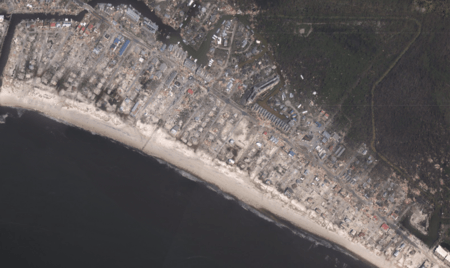
Michael hit land as a very strong Category 4 hurricane in Mexico Beach, Florida, and near Tyndall Air Force Base. In Mexico Beach, many homes were destroyed or washed away by the storm surge. Some roofs even landed on the main road. The National Guard helped rescue about 20 people.
Tyndall Air Force Base suffered major damage, with almost every building having roof damage. A wind gust of 129 miles per hour (208 km/h) was recorded there. Debris on Interstate 10 caused the road to close for about 80 miles. In Tallahassee, many trees fell, and about 110,000 homes and businesses lost electricity. Sadly, four people died in Gadsden County, and three more in Marianna.
In Georgia, wind gusts reached 115 miles per hour (185 km/h) in Donalsonville. Over 400,000 homes and businesses in Georgia lost power. Many roads were blocked by fallen trees. In Albany, over 24,000 customers lost power. An 11-year-old girl in Seminole County died when a carport hit her home. The damage to crops in Georgia was expected to be over $1 billion.
As the storm moved through North Carolina, 490,000 customers lost power. A tree fell on a car in Statesville, killing the driver. Two other people died in Marion when they crashed into a fallen tree.
In Virginia, four people, including a firefighter, were swept away by floodwaters. Another firefighter died in a car accident. A sixth person was found dead later. An EF1 tornado caused $1.8 million in damage in Norge. Over 1,200 roads were closed, and hundreds of trees fell. Up to 600,000 people lost power in Virginia.
After the Storm: Recovery Efforts
On October 9, before Hurricane Michael hit, President Donald Trump signed an emergency declaration for Florida. This allowed the Federal Emergency Management Agency (FEMA) to help with disaster efforts. FEMA provided money for emergency protective measures and removing storm debris in 14 Florida counties. They also helped with costs in 21 other counties.
On October 11, President Trump declared a major disaster in five counties: Bay, Franklin, Gulf, Taylor, and Wakulla. People in these counties could get money for home repairs, temporary housing, and loans for uninsured losses.
President Trump also signed an emergency declaration for Georgia. FEMA helped with protective measures and debris removal in 31 Georgia counties, and with protective measures in 77 other counties.
Hurricane Michael's Records
Hurricane Michael set several records because of its strength and impact.
- With winds of 155 mph (250 km/h) and a central pressure of 919 mbar when it hit land, Michael was the most intense hurricane to hit the U.S. since Hurricane Camille in 1969.
- It was the strongest hurricane by wind speed to hit the U.S. since Hurricane Andrew in 1992.
- Michael is tied for the sixth-strongest tropical cyclone by wind to affect the United States (including its territories). It is the fourth strongest to hit the mainland U.S.
- It was the second-most intense hurricane by pressure to hit Florida, after the 1935 Labor Day hurricane.
- Michael was the most intense recorded hurricane to hit land in the North Atlantic basin (including the Gulf of Mexico and Caribbean Sea) during October.
- It was one of only two Category 4 hurricanes to hit Florida in October. The other was Hurricane King in 1950.
- Michael was the first recorded Category 4 hurricane to strike the Florida Panhandle since reliable records began in 1851.
- As it moved inland into southwestern Georgia, Michael was still a Category 3 hurricane with winds of 115 mph (185 km/h). This made it the first storm to impact Georgia as a major hurricane since 1898.
Images for kids
-
Downed trees and power lines on SR 253 in Seminole County, Georgia
See also
 In Spanish: Huracán Michael para niños
In Spanish: Huracán Michael para niños


